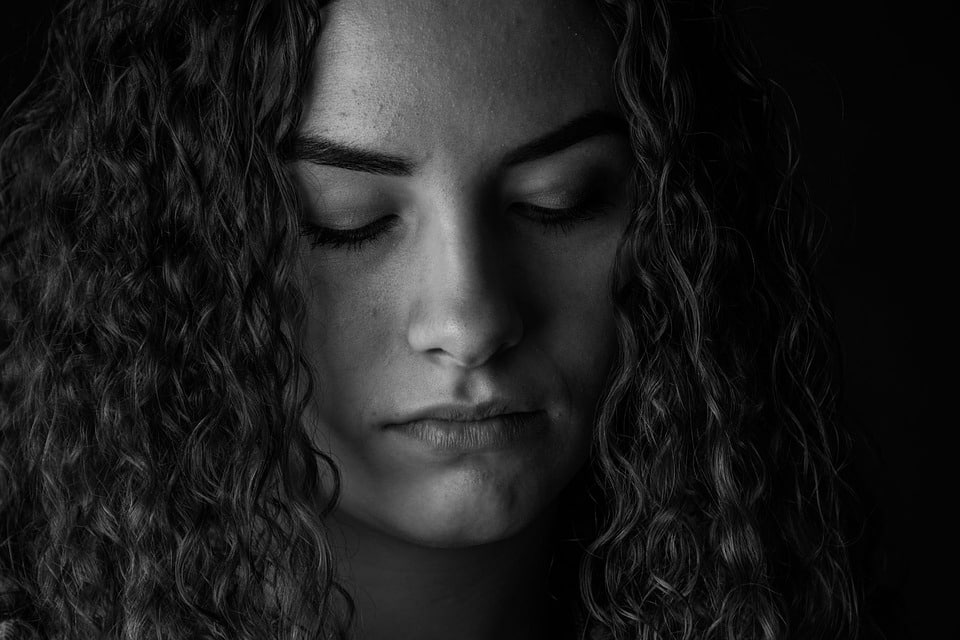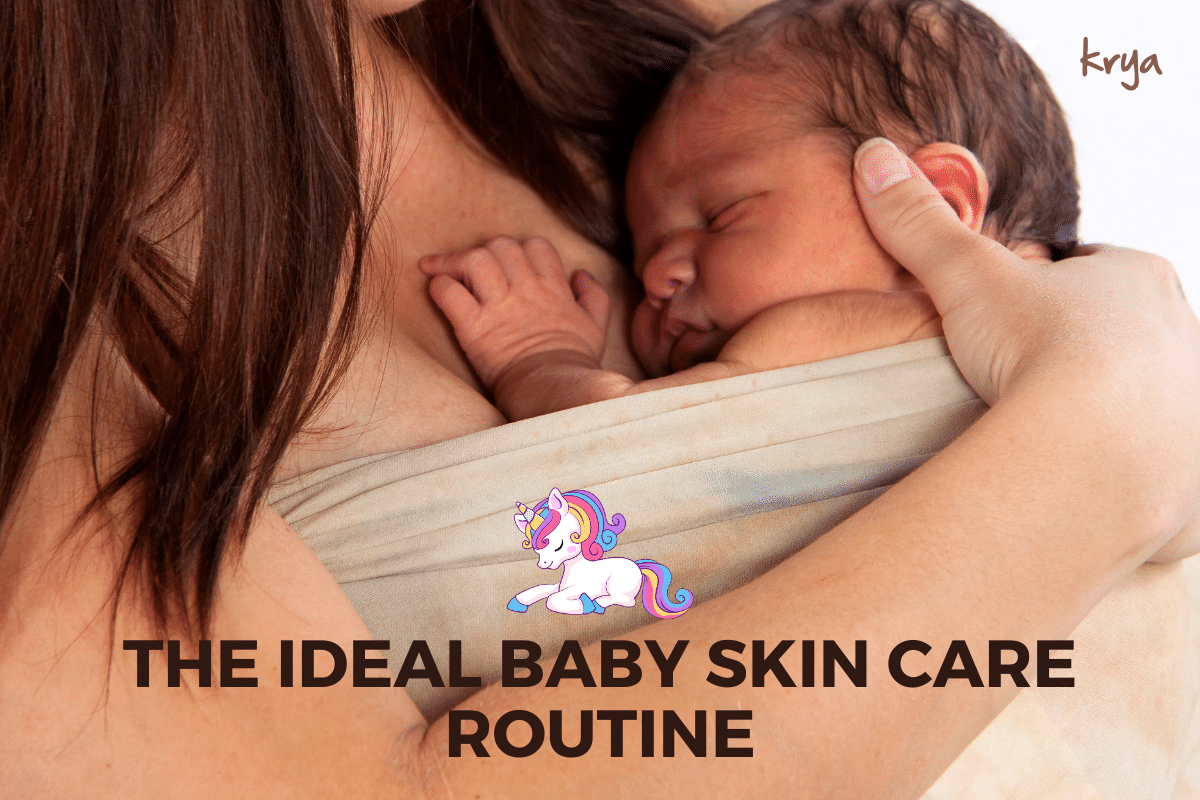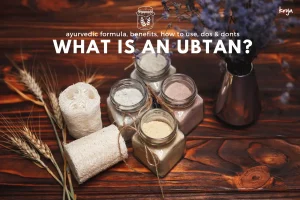This post was last updated on August 12, 2021 by Preethi Sukumaran
Are large, visible open pores frustrating you? Are you looking for natural ways to refine the appearance of open pores on your skin and heal oily clogged skin more naturally? Read on for how Ayurveda treats the problem of open pores and what you can do to support your skin in its healing.
Open Pores at Krya
At Krya, we get many queries on handling and healing oily skin. One of the biggest concerns our customers grapple with is how oily skin tends to have visible large open pores, leaving skin looking uneven . Long after childhood acne is gone, women are resigned to the visible evidence of their childhood acne in the form of open pores.
This has become a bigger problem today with the K beauty trend. Korean skin care norms promote “glass skin” . This is made possible by a certain kind of genetics, and a relentlessness complicated Beauty routine that involves using many animal derived ingredients, which work only to temporarily “refine” the skin.
It is no wonder with such beauty trends, we get desperate emails like the two we have shared below:
Email 1:
“Dear Team Krya
I have large visible open pores, oily looking skin and craters and blemishes which are remnants of my acne filled youth.
Can you help with this?”
Email 2:
“Dear Team Krya,
I am 35. My skin tends to be normal – oily and has a tendency to break out around my periods. My pores are generally large and oily looking. And this is made extra obvious to me when I visit my parlour, and I am told to try chemical peels or microdermabrasion to minimise this.
Is there any natural, non invasive way to get better skin?”
What are open pores?
Have you been “expertly diagnosed” by your parlour facialist as having open pores? Or has a quick perusal of a beauty magazine suggested this term to you? Does your make-up look cake-y on application ? Has a makeup expert suggested that this is because of your open pores?

Open pores are our chief complaint at Krya as well, and the reason why so many women write to us asking for a better solution to their skincare woes.
Open pores are a mysterious animal though. While commonly experienced and often self diagnosed by many of us, there is no strict definition from a Dermatology point of view, as to what might constitute an open pore. Neither is there a precise definition of when the pilosebaceous ostia (sweat and sebum expelling openings) are enlarged enough to call them an open / magnified pore.
Clinical dermatological Research on open pores
A study published in the Clinical, Cosmetic and Investigational Dermatology journal in 2015 gives us some clues about these open pores. This study analysed responses from a multi ethnic group of women (Chinese, Japanese, Indian, Brazilian, French etc) of 2400+ women from the age group of 18 – 80.
Some of the conclusions this study drew were as follows:
- There is no one definition of what is a common open pore. Pore sizes varied across ethnicity, age and region
- The lowest variation in pore size was seen in Chinese and Japanese women – this means that differences between “visible pores” and “refined skin” among the Chinese and Japanese are less obvious
- There is a slight increase in pore size from the age of 18 to the age of 40 across all ethnicities and regions. This increase was the most marked among Indians and Brazilians (this increase was not statistically significant nor was it rigorously tested having a reasonable sample size of the full age spectrum in each ethnicity). So the complaint among Indian women above 25-30 years saying that their pores look larger / more visible is statistically valid.
Despite not reaching too many statistically significant conclusions, the study concluded that aging affected pore size in some way, and there were differences in pore size across ethnicities. Cultural conditioning and expectations of beauty largely determined each ethnic groups focus on open pores.
Unsurprisingly, the Brazilians and Indians were extremely concerned by their open pores. We can surmise that this homogeneity of beauty standards has to also do with standardized, multi regional mass market advertising. We recently did a thought piece on fairness and how standards for fair skin have changed and morphed in India. Do read this piece here.
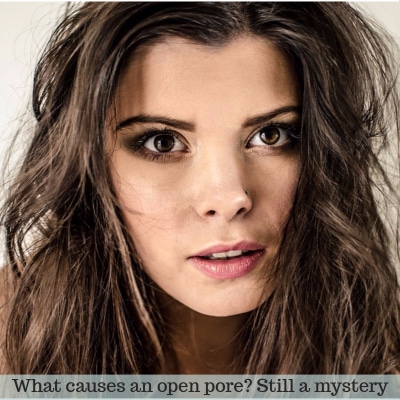
Current aesthetic beliefs and practices around open pores:
Pore shrinking is a very common beauty service offered at beauty parlours and dermatologists’ practice. This service exists despite the fact that open pores are not a serious part of any dermatology text. There is also no clear cut acceptable research to show what causes their enlargement to take place.
Opinions among dermatologists vary about the origin of these open pores. Some believe that we are simply referring to old acne scars and pits as open pores. This is explained by the fact that every open pore contains the openings to several pilosebaceous ostia (pores). So what we call an open pore is simply the unevenness of skin.
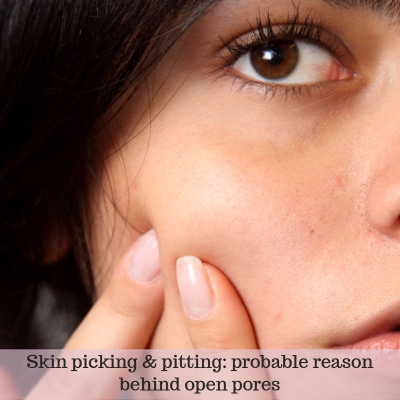
Dermatologists attached to beauty companies have a different take on this. Many beauty companies say that open pores are a natural result of skin cells being clogged with dead cells, sebum and cosmetic products. As the ostia are clogged by these toxins, the opening of the ostia widens to help the skin perform its excretory function properly. This explains the slowly expanding nature of the open pore.
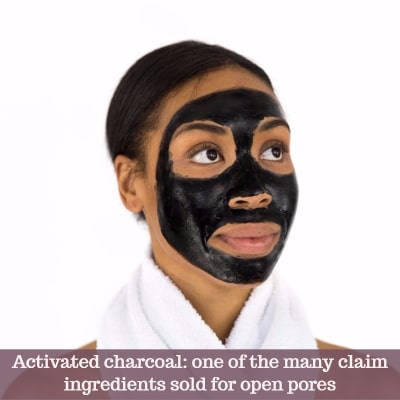
Depending upon whose explanation you choose to believe, different kinds of beauty products and services are now available to tackle open pores.
For those who believe in the “clogged pore” theory, products and services designed to “unclog” skin exist. Hence you have exfoliating scrubs, toners, and foaming / non foaming face washes being sold with claim ingredients as varied as tea tree ,rosemary to activated charcoal.
For dermatologists who are still on the fence about the cause behind open pores, services to peel or sandpaper away the top layer of skin are the treatments of choice. Hence chemical peels and micro dermabrasion are suggested to literally sand paper the skin and remove its outer layer and encourage a new and smoother layer of skin to grow back.
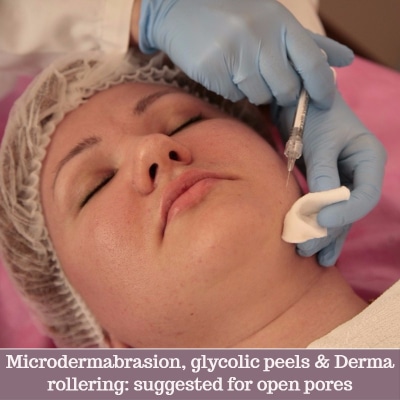
The Ayurvedic point of view on open pores:
Let’s start with the most obvious point:
Ayurveda does NOT have any point of view on open pores. Such a condition is not mentioned or referenced in the texts: however several modern skin concerns like pigmentation, tanning, melasma, chloasma, vitiligo, leucoderma etc are all mentioned in Ayurveda with very good solutions for these problems.
What Ayurveda does have, is a very strong, well researched point of view on skin health, and several rational explanations to make us understand why our skin texture and nature changes with age. Ayurveda also focuses heavily on health of Srotas. Through various practices and products, Srotas are supposed to be kept pliable and clean in order to function well.
The Srotas are the minute channels of the skin which end in microscopic openings in the surface of the skin. The Srotas allow the skin to perform its function as a thermo-regulatory organ and also aid in the transport of Mala (wastes) from within the body through the channel of sweda (sweat) via the skin. Therefore Ayurveda considers the health of Srotas as absolutely key to the body’s state of health and well being. Only when the body’s Srotas are healthy, clean, unclogged , well nourished and flexible, can they contract, expand and push wastes out of the body. When the body’s waste expelling mechanism is healthy, the body is in a state of harmony.
The Rise of Pitta dosha in middle age:
First, Ayurveda says that “pitta” strikes us at 2 phases in our life. The first is at puberty, when it is triggered by hormonal changes in the body. The second time Pitta strikes is in middle age (defined in Ayurveda and Siddha as the age between 30 – 60). The increase in Pitta in middle age is due to the increase in responsibilities that we face in this period, necessitating the gifts that enhanced Pitta dosha gives us.
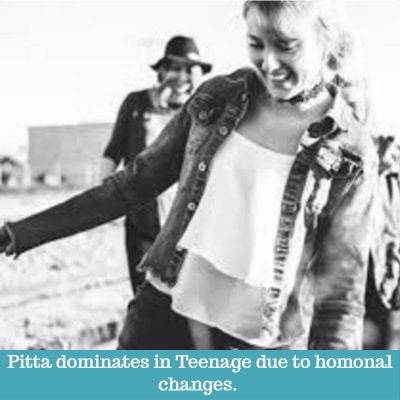
Pitta dosha is the dosha responsible for decisiveness, an ability to complete things, the ability to lead. In short the ability to lead your family, shoulder responsibilities, make financial decisions , plan your career, etc. When we enter Ayurvedic middle age, we throw away the carefree nature of childhood and become responsible . We get married, perhaps start a family, shoulder responsibilities for our parents, take charge of our careers, etc. It is therefore no wonder that we draw upon the qualities of Pitta dosha to see us through this time.
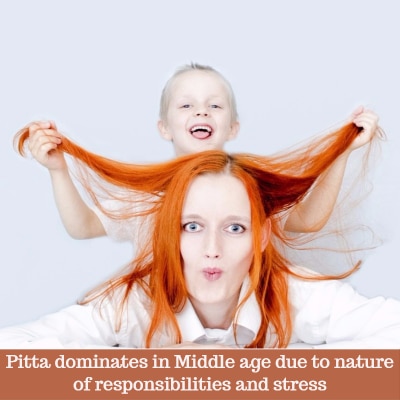
However, high use or over use of a dosha, leaves the body vulnerable to the effects of that particular dosha being aggravated. Also, as per Ayurveda, like attracts like. So when we are overusing a particular Dosha, we tend to aggravate it further by eating Pitta stimulating foods or doing Pitta increasing activities.
So in our Pitta phase of life, we may see ourselves gravitating towards sharp, spicy, tangy foods (Chinese hot and sour anyone?). We may also became more impatient, get stressed out more, and become less tolerant to things not proceeding as per our plan.
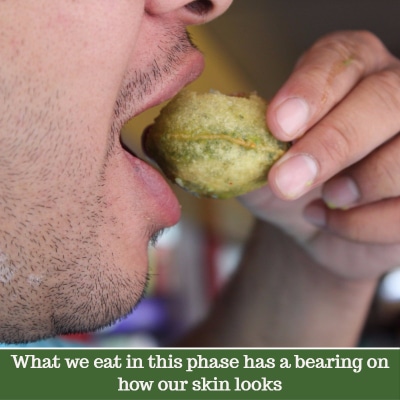
When this mixture of life phase, foods and behaviour all overload Pitta dosha, we see its effects on the way our body functions and the way our skin and hair looks.
What Pitta aggravated skin and hair look like:
We have seen the basic nature of Pitta dosha before: Ayurveda terms Pitta dosha as “sara” or liquid, “teekshna” or intense, dravya (oily and spreading nature), foul smelling, hot and quick to spread.
If we interpret this in skin terms: we see that Pitta afflicted skin is oily, sweats easily, reacts quickly to disturbances in pitta (quick skin rash), is usually warm to touch or flushed looking, and can have a foul odour .
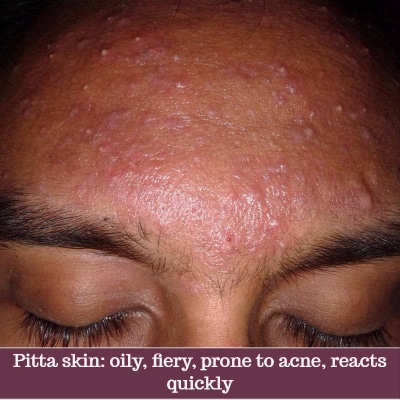
On hair and scalp we see something similar: pitta afflicted hair has an oily scalp, can sweat easily, and hair is usually prematurely grey, and has reddish tints in it naturally (like Agni / fire). Pitta aggravated hair thins easily especially in the parting and the hair is usually fine and not very thick.

How pitta aggravation enlarges and worsens open pores:
High pitta in the body dilates the blood vessels, and heats up skin. In this scenario, you will have a greater amount of sebum being secreted. This excessive sebum attracts the invasion of micro organisms. As they multiply, they fill the skin surface with debris and dead cells.
When pitta is aggravated, we are repetitively drawn to eating Pitta aggravating food. If you respond to this call and eat junk food, and sharp and spicy food, you are also reducing the body’s ability to metabolise food properly . As metabolism is impaired, there is an internal build up of Ama / toxins.
This internal toxin build up and external clogging affects Srotas at both ends. Without enough free space to perform their normal functions, they are forced to expand further resulting in larger and more visible open pores. The excess material in the srotas is ejected improperly onto skin in the form of whiteheads and black heads and acne.
This can make your scars and pits look larger, and generate a lot of excess material which should be removed gently from skin.
How is Pitta aggravated skin treated in Ayurveda?
All Ayurvedic skin and hair care starts with the right diet and regimen. So, there is no point in treating pitta aggravated skin without correcting the underlying diet or behaviors.
Once we have tackled the diet, and adopted the right lifestyle practices to control excess Pitta, we look at specific herbs and products that Ayurveda recommends for Pitta aggravated skin.
Pitta aggravated skin is treated extremely gently in Ayurveda. This is because pitta reactions start very fast and spread in an uncontrolled manner through the skin (imagine a forest fire raging out of control, and you will get this analogy). So Ayurvedic skin care for pitta problems (open pores, oiliness and acne) has a very gentle approach.
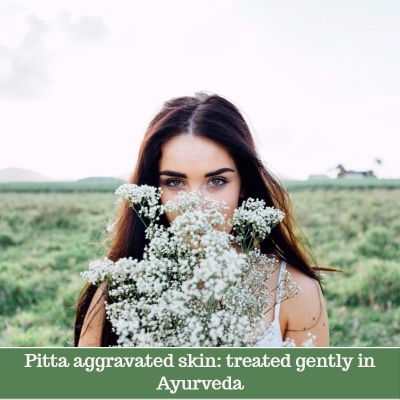
Ayurvedic Srota cleansing
The original Ayurvedic equivalent of ostia is the Srota. We have seen how Srota are present all over skin and help in heat exchange, excretion of sweat and toxins and also produce minute amounts of sebum to help skin stay at the right pH and well moisturised. Ayurveda says it is critical to cleanse these Srotas properly to ensure they are debris and clog free and open to doing their job well. This cleansing has to be done WITHOUT drying out the srotas. When Srotas are dry, they do not expand and contract properly, so the skin’s job of toxin removal and heat regulation is not done properly.
Srotas have to be cleansed with the adsorption and pressure method as per Ayurveda. As Ayurveda says each Srota is like a tube, we have to scoop out debris and dirt from inside the tube (think of cleaning a slim plastic straw). Soaps and face washes use surfactants that only clean the opening of the srotas. But, because of their drying nature, they also suck out moisture from skin. So the dirt and debris lodged in the srotas still remain and the srotas lose their elasticity.
So a mixture of grains and lentils and herbs that are ground and sifted to a very small particle size are used. By the gentle pressure they exert on the skin surface, the Srotas are encouraged to open up and dislodge dirt trapped inside. The cleansing base adheres to this dirt and excess sebum and sponges off the dirt and debris by skin.
As there is no surfactant use, there is no stripping of sebum from skin.
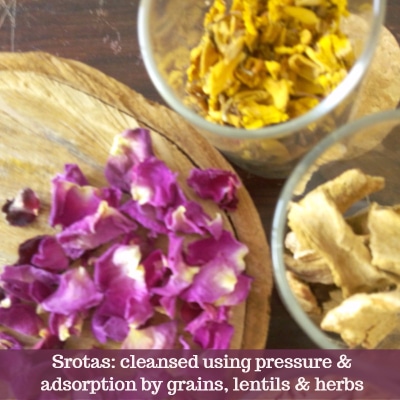
Use of pitta balancing, cooling herbs
To counter excessive pitta, Ayurveda suggests using specific, pitta balancing herbs. These herbs counterbalance Pitta in the skin surface by using sweet and bitter qualities to pacify aggravated Pitta. Therefore herbs famously used for Pitta aggravated skin are Usheera (Vetiver), Chandana (Sandal), Sariva (Indian Sarsaparilla), Avartaki (Cassia auriculata), Bilwa, etc.
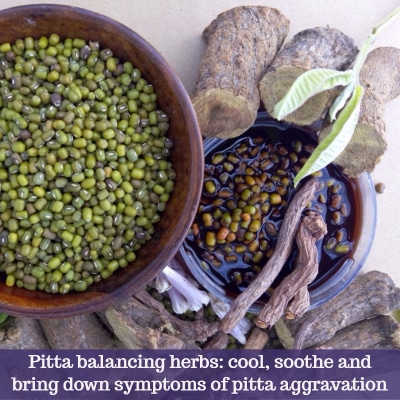
These herbs counter the warm and hot nature of Pitta aggravated skin and bring a soothing, cooling effect on skin, besides balancing Pitta and improving the complexion.
Use of bitter, anti bacterial and anti bacterial herbs
Because of the nature of Pitta to generate so much liquid (sweat and sebum), it tends to create an ideal breeding ground for bacteria. Hence all Ayurvedic formulations for pitta prone skin use bitter, anti bacterial herbs to help keep invasive micro organisms out of skin. Obviously, these herbs do not work like standard synthetic anti bacterial ingredients like Triclosan do.
Instead, Ayurvedic herbs work along with the body’s microbiome layer and helps keep invading organisms out by boosting conditions for friendly organisms, and working on keeping out only harmful micro organisms. Most importantly, we do not develop resistance to anti bacterial herbs – like we often do to ingredients like Triclosan.
Some of these herbs include Nimba (Azadirachta indica), Bhui nimba (Kalmegh), Triphala (blend of 3 Ayurvedic fruits), Bakuchi (Psoralea cordifolia), etc.
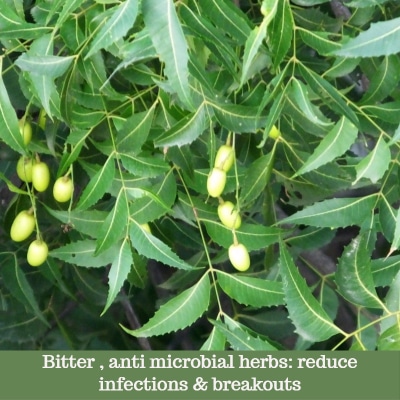
Use of complexion improving and blemish correcting herbs
Ayurveda classifies many herbs as “Kantivardhaka” herbs, which means complexion improving. When we use the word Kanthi vardhaka, we mean something that is very different from “fairness”.
Ayurveda and Indic tradition does not especially value “fair skin”. Skin is only measured for its health aspects and ability to function well. So smoothness, quality and evenness of complexion, etc are all ways of understanding the underlying balance of skin.
Kantivardhaka herbs work to improve micro circulation of the skin and boost cellular repair. They therefore promote an even skin tone, good texture and good elasticity in skin. Some of these herbs include Kushta , Punarnava , Durva, Ashwagandha, etc.
Specifically in pitta aggravated skin, these herbs correct reddishness, tendency towards skin pigmentation and flushed and reddish hue of skin.
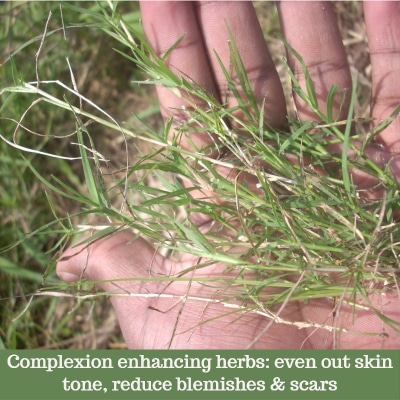
Use of Ayurvedic Mukha Lepas (facial masks) in balancing pitta in skin:
Mukha Lepa is an ayurvedic product format where we use facial masks on skin to correct various skin health issues. It is also an excellent doshghna technique which corrects unbalanced doshas on the skin. Ayurvedic mukha lepas (face masks) are excellent for balancing pitta in the skin. So much so , that the texts tells us that regular use of Mukha Lepa also helps “Dhri” or vision.
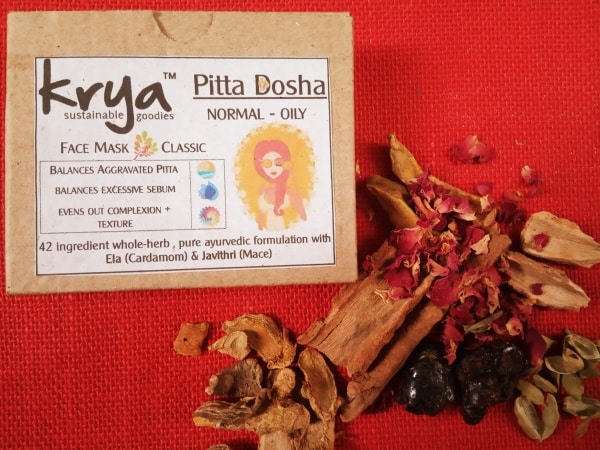
In the case of open pores and pitta aggravation of skin, the use of a Mukha Lepa (face mask) formulated to balance Pitta, we can see excellent results in deep cleansing the srotas, balancing oiliness, drying out excess oiliness, cooling and refreshing skin and improve the evenness and texture of skin.
Krya has excellent Mukha lepa options for Pitta prone skin. For more on our Mukha Lepa category, please read out detailed blog post on the subject.
Judicious use of skin balancing facial oils to maintain elasticity of Srotas :
Ayurveda suggests a 2 pronged approach to skin care. The first is cleansing with live, whole grains and herbs. This ensures the srotas are thorough cleaned and that skin is not stripped of its natural protective oils. The second is to augment the skin’s natural facial oils by a carefully prepared botanical oil.
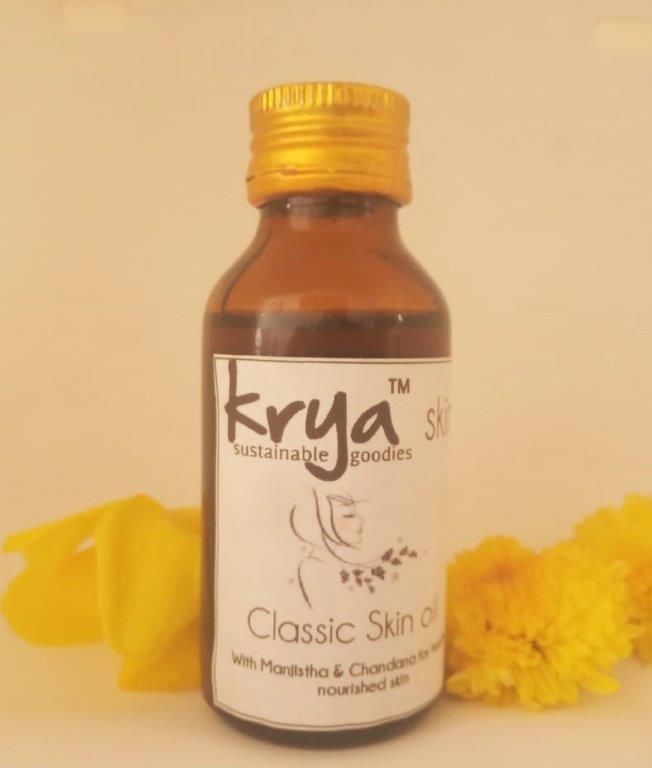
When we apply herb, flower and fruit infused botanical oils on skin, we help improve the elasticity of the srotas. We also selectively encourage the growth of a healthy microbiome. Balance and health are restored to skin.
Krya products for oily, pitta skin with open pores
We discussed the ayurvedic techniques to take care of oily, pitta aggravated skin, by using certain kinds of herbs and product formats to help cool, refresh, soothe and make oily , pitta prone skin more even, smooth and radiant. To cleanse and care for this skin, it is important to use the correct pitta balancing products. At Krya we have many products designed for Pitta prone facial skin.
The Krya Classic facial system for Women with the Krya Classic Face Wash, the Krya Classic Mukha Lepa (Face Mask) and the Krya Classic Facial Oil / Serum, is an excellent range that helps with open pores, flushed, uneven skin, acne scars and blemishes and oily skin.
For Men, the Krya Men’s Classic Facial range with the Krya Men’s Classic Face Wash, The Krya Men’s Classic Mukha Lepa (Face Mask), and the Krya classic Skin Serum / Oil is the correct range. This range is formulated for aggravated Pitta based skin for Men – in Men’s skin the Pitta levels are higher and the skin is slightly thicker thus giving rise to deeper clogging and pits. The Krya Men’s Classic Face range is excellent at helping heal this skin and make it look its best.
Pitta Prakriti skin also needs overall pitta balance. Krya’s Pitta based Snana Choornam products like the Krya Classic Bodywash, the Krya Classic Plus Bodywash, and the Krya Men’s Bodywash are also very useful in balancing Pitta in the body overall. These should be used instead of a soap for daily bathing and to cleanse the body.
For more tips and further suggestions on controlling and refining open pores, please read our follow up article on this subject.
To sum up: how Ayurveda views and treats open pores and pitta skin
We have discussed open pores, and seen the differences between how they are treated by Western Cosmetic ‘Science’ and Ayurveda.
Ayurveda focuses on holistic living and looks at the sum of everything an individual is doing to treat problems that may arise. Therefore, this post discussed how the right diet, right lifestyle practices combined with the right herbs and skin care routine can help look after pitta prone skin.
One of the biggest differences in how Ayurveda treats skin lies in the ayurvedic concept of Srotas. This post saw how Srota health = Skin health . We also discussed why Ayurveda recommends the use of special facial cleansers made of grains , lentils and herbs to cleanse and care for skin.
This is why chemical peels or microdermabrasion are not a long lasting holistic solution to open pores, breakouts and oily skin. Unless we tackle oily skin both internally and externally, we cannot reverse the appearance of oily pores or blemishes.
We hope this post gave you good insights into your skin and explained how to care for skin. Please do try the methods we have recommended to cleanse and care for oily, pitta-prone skin.
If you have any queries on the above, please call us (0-75500-89090) or write to us.

